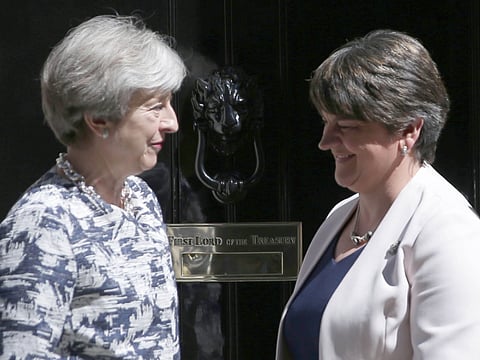Sending confusing signals on Brexit
After months of false starts, the rickety craft of May’s strategy briefly took flight, and then promptly nose-dived

After 18 months of a phoney war — of talking, positioning and negotiating behind the scenes — the rickety craft of Theresa May’s Brexit strategy briefly took flight on Monday, and then promptly nose-dived back to earth.
Within hours of Ireland’s state broadcaster reporting that the British Prime Minister had agreed that the United Kingdom would ensure “continued regulatory alignment” between Northern Ireland and the European Union (EU), political gravity took over.
If the game of leaking the compromise was to railroad May into signing off the deal at her lunch with Jean-Claude Juncker, it backfired spectacularly, exposing this most carefully worded of texts to more scrutiny than it could bear.
Wrapped up in the language was a subtle compromise that officials had worked on for the best part of a month, and tried to be all things to all parties.
The UK had not been forced to agree to Ireland’s initial demand for “no regulatory divergence”; instead, it was electing to use new-found freedoms after Brexit to maintain convergence. To Dublin, the compromise gave clear reassurance that Northern Ireland would not diverge, obviating the need for a return to a hard border, while simultaneously giving Arlene Foster’s Democratic Unionist Party (DUP) a promise that the “alignment” would only be in the sectors that were relevant to the Good Friday Agreement.
It was at this moment that Brexit’s immutable logic took over, and inexorably over the course of the next few hours began to unravel the deal.
Foster was emphatic that Northern Ireland must not be treated differently from any other part of the UK. The North, she said, could not become a regulatory exclave of the Republic, or the EU itself. But how then to square her demand for equality, with the idea that Northern Ireland was apparently being granted a soft Brexit that seemed to make it part of the EU’s single market and customs union in all but name?
Either Northern Ireland was being treated differently, which would imply an east-west border to monitor mainland Britain’s divergent trade policy after Brexit, or, contrary to everything we have been told by May, the UK was not diverging at all? It could not be both. In trying to placate the DUP, Downing Street signalled that May was signing up to “regulatory alignment” for the whole of the UK, but only in those areas that impacted the Irish border question, principally agriculture and electricity.
But there lies the rub. If that is the case — and there are some 140 areas that have reportedly been identified as crucial for north-south cooperation in Ireland — how free, really, would the UK be to diverge with Liam Fox’s much-vaunted independent trade policy?
EU officials are privately very clear that the “fudge” on Ireland leaves little room for manoeuvre. The level of regulatory convergence required to avoid a hard border — and the east-west border that implies — is inescapable.
So, either May was signing up the UK to vast swathes of convergence with the EU, something that British Foreign Secretary Boris Johnson and free-trading Brexiteers have explicitly ruled out, or she was selling her DUP partners down the river with false promises.
— The Telegraph Group Limited, London, 2017
Peter Foster is a columnist and the Europe editor of the Daily Telegraph.
Sign up for the Daily Briefing
Get the latest news and updates straight to your inbox



